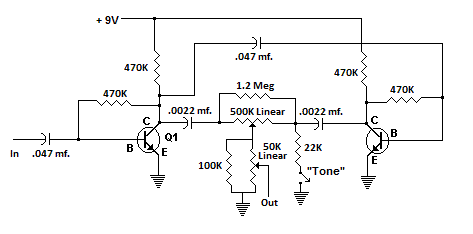
The Fur's Rite - A Fuzzrite Clone
By Steve Daniels, Small Bear Electronics LLC
© 2017 By Small Bear Electronics LLC
The Mosrite Fuzzrite was a two-transistor fuzz used by many '60s and '70s groups. Most people say that it didn't/doesn't sound quite like anything else; I find it less fuzzy and more snarly than a Fuzz Face, less saturated than a Big Muff, but with plenty of sustain if it's biased correctly. This article will eventually be a full build-it project; for now, here are schems for the silicon and germanium versions with my recommendations for transistor selection and biasing.
The original pedal used 350K reverse audio for the tone pot and 33K audio for level. Some clever people on the Forums worked out the tapering resistors that allow using standard pot values while getting similar response, and those are shown in this schem. Also shown is the "Tone" switch.

In breadboarding, I got my best (and good!) results with very low gain devices--10 to 20 for Q1 and 20 to 30 for Q2. The usual suspects like the 2N3904 will work, but IME the tone pot breaks into feedback at full CW. A series-connected 250K "cleanup" pot is helpful with taming this.
I based my germanium version on an on-line schematic that specified a 2N2613 for Q1 and a 2N408 for Q2. I suggest ignoring the part numbers and finding a high-gain somewhat leaky (250 to 500 microamps) device for Q1 and a low-gain/low leakage (under 80 microamps) remainder device for Q2. The original schem has a 10 meg resistor biasing Q1. I prefer it lower...YMMV.

If the sound of this version is gated, try reducing the value of the 100K resistor. Hybrids Welcome!: Silicon works well for Q2, and it need not be anything exotic. I was happy with a 2N4125, gain of about 120.
I added the 180K padding resistor in the volume circuit because the output overdrove my amp when I was using my Bluesbird with its humbuckers. You may not need that resistor with single-coil pickups.
Special Note: I also set up the germanium version with NPN devices of specs similar to the above: Q1 was "Hot Germanium," high-gain, somewhat leaky, and Q2 was one of my low-gain/ultra low-leakage Sylvania types. To my ears, the sound is excellent and the devices are, for the moment, still inexpensive. Try parts from your remainder bag (or mine)...just find the lowest leakage you can for Q2. Again, low-gain silicon can be subbed for Q2. Remember to reverse the battery polarity!